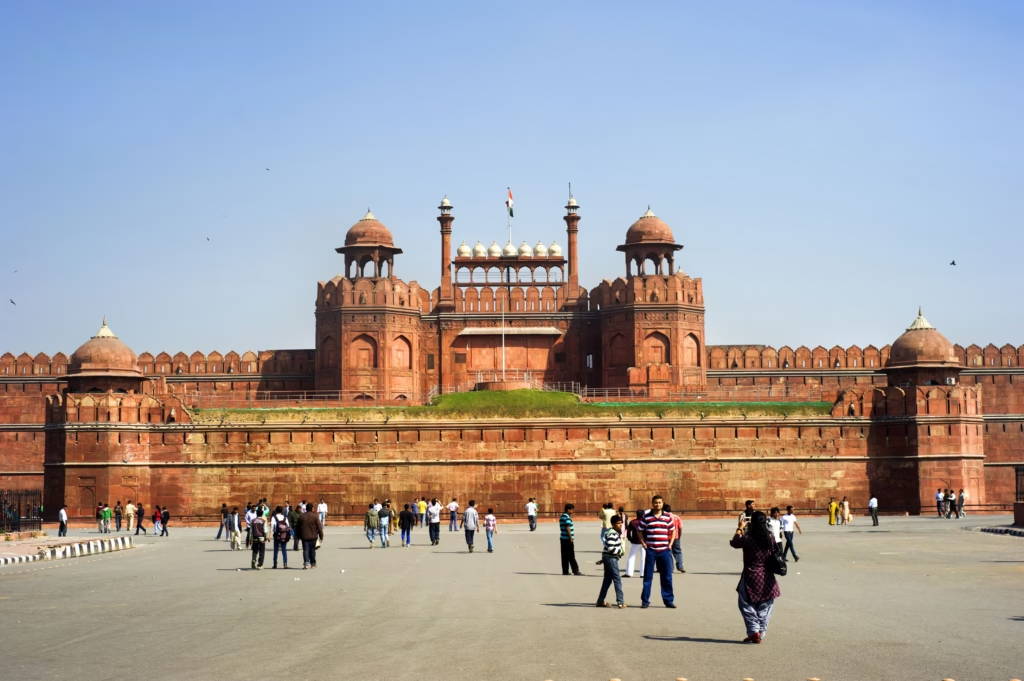Tourist Places

Red Fort: A Timeless Icon of India’s Heritage
Introduction
The Red Fort, also known as Lal Qila, is a majestic example of India’s rich historic and architectural heritage. In Old Delhi, this famous fort was the primary residence of Mughal emperors for almost 200 years, from the moment of its construction in 1638 by Emperor Shah Jahan to the British conquest in 1857. Its imposing red sandstone walls, regal gateways, and beautiful Mughal craftsmanship establish it as one of India’s most renowned monuments.
A UNESCO World Heritage Site, the Red Fort is not merely a historical building but a testament to India’s independence, as it is the venue for the annual Independence Day festivities, where the Prime Minister unfurls the national flag and addresses the nation.
Historical Background
Construction & Mughal Era
The Red Fort was ordered by Shah Jahan, the fifth Mughal emperor, in 1638 when he resolved to transfer his capital from Agra to Delhi. This relocation resulted in the establishment of Shahjahanabad, a city within a fort enclosed with high walls that later came to be known as Old Delhi, with the Red Fort at the center.
Designed by the renowned architect Ustad Ahmad Lahori, who also designed the Taj Mahal, the Red Fort was completed in 1648 and served as the political and cultural center of the Mughal empire. It served both as a royal palace and a strategic military stronghold.
British Occupation & Post-Independence
The 1857 Revolt, also referred to as the First War of Indian Independence, witnessed the British overpowering the Mughal army and capturing the Red Fort. Bahadur Shah Zafar, the last emperor of the Mughal dynasty, was detained here before his deportation to Rangoon (now Yangon, Myanmar).
Since India gained independent in 1947, the Red Fort has been a symbol of liberation. On every 15th August, the Prime Minister of India raises the national flag at the Lahori Gate and speaks to the nation, viewed by millions all over the nation.
Architectural Marvel
The Red Fort is an architectural wonder, depicting the combination of Persian, Timurid, and Indian architecture. Its imposing walls, 2.5 kilometers long, reach a height of 33 meters and are constructed using imposing red sandstone, for which it has been named.
Major Buildings within the Red Fort
Lahori Gate – The primary entrance, named after the direction in which it faces Lahore, Pakistan.
Delhi Gate – The subsidiary entrance, featuring elaborate Mughal carvings.
Diwan-i-Aam – The imperial commoner audience hall where emperors spoke to commoners.
Diwan-i-Khas – The private imperial meeting hall where royal conclaves took place.
Moti Masjid – A beautiful white marble mosque constructed by Aurangzeb.
Rang Mahal – The imperial women’s quarters, famous for its lovely frescoes and water courses.
Khas Mahal – The emperor’s private palace, reflecting delicate Mughal craftsmanship.
Baoli – A very old stepwell for the storage of water.
Each of these buildings features elaborately carved flowers, pietra dura inlays, and Persian-inspired design, epitomizing the richness of the Mughal Empire.
Cultural Significance
Red Fort is not only a historical monument but also a cultural icon that has seen centuries of change. It has inspired writers, artists, and historians, becoming the inspiration for many literary and artistic creations.
Independence Day Celebrations
The Red Fort has been hosting India’s Independence Day since 1947, an important tradition. Thousands of people have come to watch the Prime Minister’s address, a grand parade, and cultural events, reiterating the importance of the fort as a representation of India’s independence.
Sound and Light Show
The Red Fort Sound and Light Show is an attraction not to be missed, tracing the glorious history of the Mughal period with color lights and dramatic narration. This interactive experience showcases the magnificence of the fort, bringing history to life for tourists.
Tourism & Accessibility
Now, the Red Fort draws millions of tourists every year. It is a tourist destination and continues to be among the most popular monuments in India, with its magnificence casting an indelible impression.
Conservation & UNESCO Status
The Red Fort became a UNESCO World Heritage Site in 2007 because of its architectural excellence and historical significance. Conservation work by the Archaeological Survey of India (ASI) keeps its magnificence intact.
But the fort has also struggled with problems of pollution, deterioration, and overpopulation. Conservation efforts persist in striving to preserve its glory while encouraging eco-friendly tourism.
Conclusion
The Red Fort is not simply an architectural marvel—it is a living embodiment of India’s history, current situation, and future. From its resplendent Mughal-period glory to its status as the center of India’s Independence Day ceremonies, the fort represents heritage, tenacity, and national pride.
A tour of the Red Fort is an odyssey through time, revealing the splendor of the Mughals, the agony of India’s freedom fighters, and the majesty of a nation that celebrates its heritage while welcoming the present.
Whether you’re an architecture buff, a history buff, or a tourist, a tour of the Red Fort is an experience you’ll never forget that connects you with India’s heart.